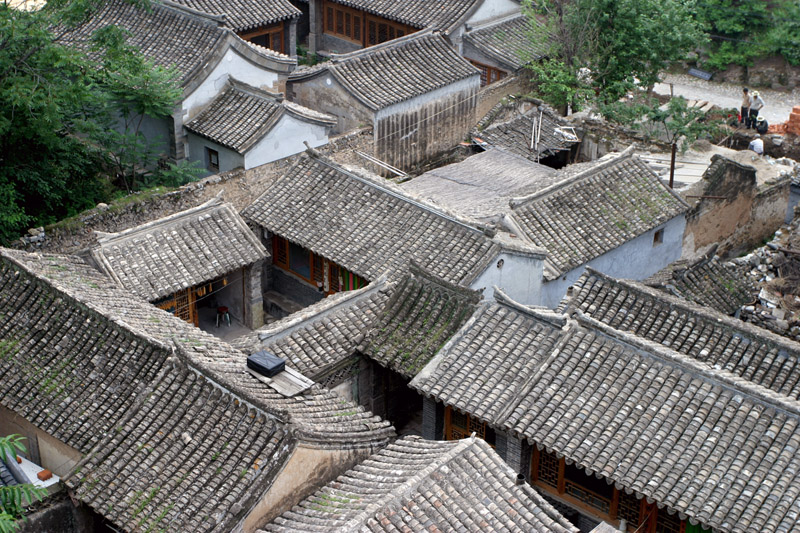The october Chinese national holidays are coming, you might be considering around Beijing for a couple of days, here is a suggestion: the Mentougou area west of Beijing, a range of mountains with many scenic spots, the most famous of them being the Cuandixia Ancient Ming village that has been preserved through time.
This a place worth a visit where you can make a pause and even spend a night, it is full of guest houses (actually, Cuandixia is a guesthouse village living thanks to tourism).
Cuandixia still has original courtyards from Ming (1368-1644) and Qing (1616-1911) dynasties, the village is said to have been founded during the period of Emperor Hongle (1403-1424) and is not a very large place, there is 600 houses organized in around 70 quadrangles. You’ll have a look on how was the traditional villages of northeastern classical China.
A few things about Cuandixia:
The name of the village is 爨地下, Cuandixia, it begins with this mysterious character “Cuan”, with 30 strokes (many villages have this family name).
爨
This is a word seldom used, the Shuowen Jiezi, the first Chinese dictionnary dating back to the 2nd century, says that it means ” cooking fire, cooking range, firewood or light a fire to cook”.
Many legends try to explain the origins of this name: it is said that Laozi himself, the founder of Taoism collected artefacts and did alchemy in the northwest of the village, in the little Cuanbaoyu channel, the village is located under this channel, hence the name, or maybe it is because of the name of a cliff called “Cuan”, the village is under this cliff.
Cuandixia, a mountain village 650 meters high, is located 90 kilometers away from Beijing city centre, in ancient times it used to be an important post road, it is as well a military route in Hebei leading from Beijing to Mongolia and a place with good soil conditions which made a good place for moutain agriculture.
The descendants of Han Shining
The people living there, managing their guesthouses and still performing a little agriculture, are generation after generation, the descendants of Han Shining, a military offical of the Ming dynasty from a family that served the army for generations. The Temple you can visit in Cuandixia has records that date back to the 54th year of Emperor Kangxi (1715). Some houses have been destroyed during the Japanese invasion of China, the remains cans still be seen today.
The transportation network developed a lot since the 1950s and therefore the village lost its status as an important landmark on the road to Beijing, young people left and became city dwellers, mostly in Beijing. The village has turned itself into a tourist attraction. s
Surrounded by auspicious animals
The ancient Chinese people believed in the importance of the location of a village, they observed the landscape, looking after symbols, mythological animals. Cuandixia has good features according to Chinese geomancia, the ancient people could see auspicious animal shapes in the mountains around the village: two tigers, three dragons, a turtle, a bat, a toad… A hill even reminded the villagers of a gigantic Buddha. This was a perfect environment in ancient China where people could live in harmony with their environment. Have a look aroun you and try to read the mountain shapes.
Traditional courtyards:
This is the Chinese northeastern traditionnal housing. As in Beijing’s hutongs, you have large courtyards in the shape of quadrangles. The north room is the main room of the house, where the master lives, facing south. The south room, or Daozuo is used as a living room or a place to study, on the east and west are rooms that are reserved to the children. Around the Master north room are storages and a kitchen.
When visiting Cuandixia’s houses, you’ll discover many different things, paintings, stone carvings, calligraphy, slogan from the 1950s, this is a place to wander around an be curious.
As an example of what a master living in Cuandixia could possess, imagine a wealthy farmer with a manor in another place in Hebei, where there is as well a bean noodle workshop, an oil workshop and a wine workshop, in addition to houses within Beijing city. For a local master, there were rules and you had to possess a determinbed number of rooms according to your rank.
In Cuandixia, the Guangliang courtyard is the highest ranked courtyard, which has a really sophisticated decoration compared with the other courtards in the village.
The central Mill
The mill is a symbol of cohesion in the village, this was a place to chat, to play and exchange information.
The Grand Temple and the Niang Niang Temple
The Grand Temple was the most important place in the village and the center of spiritual life, the Guang Kwong is a figure of worship of importance among farmers, with influence on harmony in families, illnesses and courage. This is a protecting god for wealth. Another temple in Cuandixia is the Niang Niang temple, a place of worship dedicated to the goddess of pregnancy, Songzi Guanyin or Niang Niang.
You can do some beautiful hiking in the surroundings of the village.
You can get there easily durinbg the touristic season. From the Pinguoyuan station at the west end of line 1, take a bus, line 929 or 892 (this is going to take 3 hours more or less, and there is less buses in winter, so do seize the opportunity of these winter holidays) or a “black taxi” but this is hard sometimes to bargain for a good price. It depends on the day and the season, from 200 to 400 yuans.
This is not such a frequent thing to see in northwestern China, such a village. They tend to disappear in the modern Beijing. Hopefully Cuandixia is a bit far away and protected by its tourist attraction status.









Leave a Reply